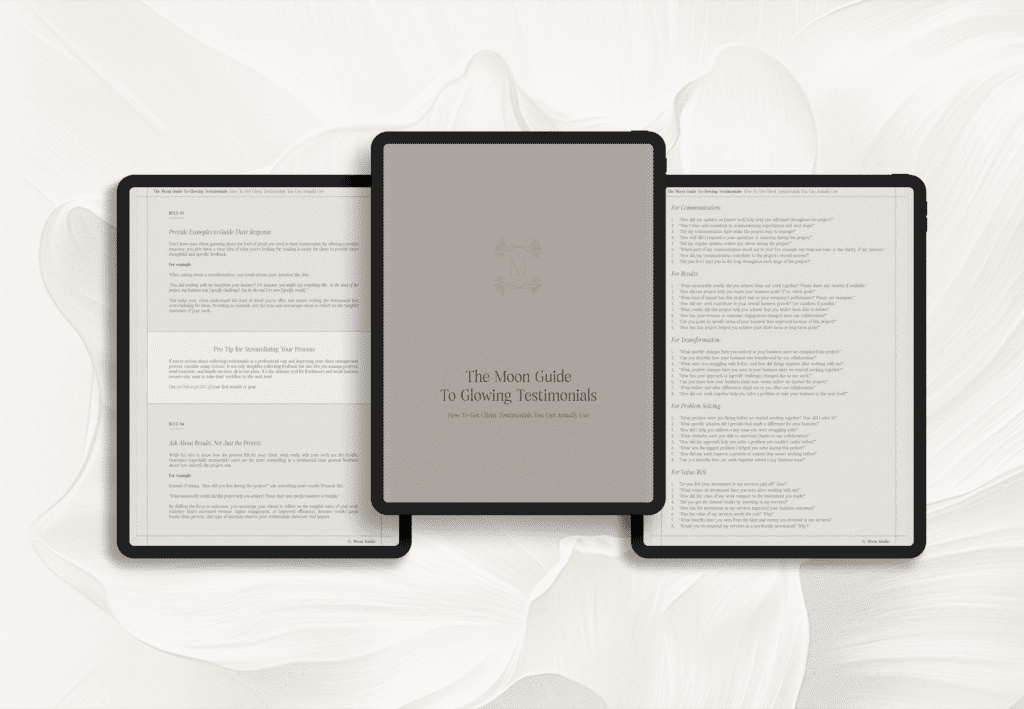How To Get Glowing Testimonials That You Can Actually Use
November 21, 2024
by Alex Rezgui

Getting a testimonial from a client can feel like chasing money that you swear is a fifty dollar bill, flapping in the breeze just out of reach.
You sprint after it, hands outstretched, only for it to dance away at the last second. And when you finally catch it, you realize… it’s just a crumpled one dollar bill. Not exactly a jackpot.
And when it comes to testimonials, they’re often 1) way too short, 2) totally off-target, or 3) not even close to something you’d proudly display on your website.
Sure, you might get the occasional client who nails it, but leaving it to luck?
Risky.
So, how do you make sure you get glowing testimonials that are actually useful?
You ask the right questions, and you make it impossible for them to give you anything less.
The 6 Rules For Getting Glowing Testimonials
No need to explain what testimonials are. You probably know why they matter (but if you need to jog your memory, read about the importance of testimonials).
At Moon Studio, we have 6 rules that make it nearly impossible for clients to “mess” things up.
The rules allow you to guide your clients step by step, showing them just how simple, painless, and quick the process can be. And when you follow these rules… well, you’ll see just how easy it is to get exactly what you need.
Rule 01: To Get a Great Answer, Ask a Purposeful Question
Broad questions like “How was your experience working with me?” often lead to vague or generic feedback. To get a more insightful testimonial, ask purposeful, targeted questions that prompt your client to think about specific aspects of your service. This approach not only makes it easier for your client to respond, but it also ensures their feedback is detailed and meaningful.
For example:
“What aspect of working with me impressed you the most? Could you share a specific example?”
Rule 02: Specific Questions Lead to Specific Answers
If you want your client to mention specific strengths, you need to guide them. A broad question like “How was my communication?” will likely get you a vague answer like “Your communication was great!”—which, while nice, doesn’t provide much value for future clients reading it.
Instead, ask questions that give your client clear direction, ensuring their testimonial highlights the details that matter most to your business.
For example:
“Did my regular updates on Asana and clear communication help reduce stress during the project?”
Rule 03: Provide Examples to Guide Their Response
Don’t leave your client guessing about the level of detail you need in their testimonials. By offering a sample response, you give them a clear idea of what you’re looking for, making it easier for them to provide more thoughtful and specific feedback.
For example:
When asking about a transformation, you could phrase your question like this:
“How did working with me transform your business? For instance, you might say something like, ‘At the start of the project, my business was [facing a specific challenge], but by the end, I’ve seen [a specific result].’”
Need A Cheat Sheet For Perfect Testimonial Questions?
Grab The Moon Guide To Glowing Testimonials right now! It includes 40-ready-to-use questions designed to get the right feedback you need from clients, covering communication, transformation, results, and more.
Rule 04: Ask About Results, Not Just the Process
While it’s nice to know how the process felt for your client, what really sells your work are the results. Outcomes (especially measurable ones) are far more compelling in a testimonial than general feedback about how smooth the project was.
For example:
Instead of asking, “How did you feel during the project?” ask something more results-focused, like:
“What measurable results did this project help you achieve? Please share any specific numbers or insights.”
Rule 05: Highlight the Transformation
People love a good “before and after” story because it’s relatable and powerful. But to get a strong transformation story, you need to guide your client away from generic answers and help them reflect on the changes your work created. Instead of asking a vague question like “Did you enjoy working with me?” ask a more targeted question.
For example:
“How did things change for you after we worked together? Where are you now compared to before we started?”
Rule 06: Make It (Really) Easy for Them
Let’s face it; clients are busy. And sometimes, they’d prefer if someone else (that’s you!) wrote the testimonial for them, so all they have to do is give it a quick review and sign off. If you’ve been waiting for feedback or know your client is strapped for time, offering to draft the testimonial yourself can be a win-win.
For example:
“Since I know you’ve got a lot on your plate, I’ve drafted a testimonial that reflects what we achieved together on your project. Feel free to make any changes or edits, and once it’s good to go, sign off on it!”
Need More Powerful Testimonial Questions? How About A Cheat Sheet?
Now that you know our 6 rules for getting amazing testimonials, you’re well on your way to gathering the right feedback from your clients.
But imagine having a list of perfectly crafted questions at your fingertips, each designed to get useful testimonials.
Questions that aim to get testimonials about your communication, transformation, results, problem-solving skills, and value. Well, you’re in luck! The Moon Guide To Glowing Testimonials has all that and more. It takes the 6 rules further and gives you 40-ready-to-use questions you can use immediately.
Enough said. Download the guide. Get glowing testimonials.
Getting the right testimonials from clients starts with asking the right questions. Consider making it easy for your clients, guiding them to provide the feedback you need most. Make it effortless! Happy testimonial hunting!